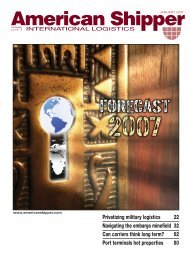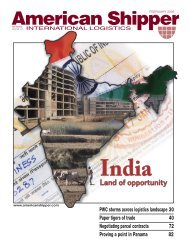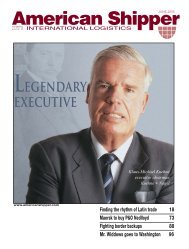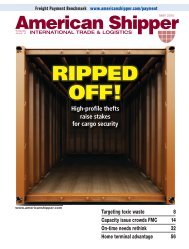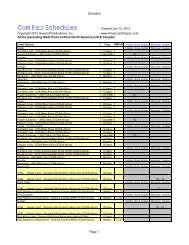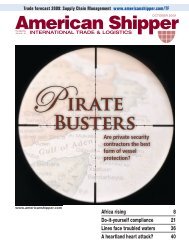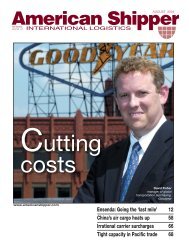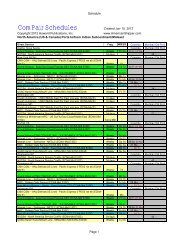The tide in the transpacific is shifting, withshippers seemingly holding all the marbleswhen it comes to negotiating freight ratesin the transpacific trade lanes this spring. Yet crumblingand congested infrastructure, volatile oil prices and continuedgrowth of Chinese exports is putting a damper on theindustry.So it’s in this climate that more than 1,100 in the shippingindustry gathered in Long Beach in earlyMarch to get the skinny on transpacifictrade — and they found out that freightrates are likely to drop, while congestionand infrastructure problems shouldn’tsurface in 2006.So pretty good news for everyone, right?Well, good news unless you’re a carrier, orunless you plan on continuing to ship pastthis year. That’s because most analysts atthe conference predicted a congestion crisiswill be upon the West Coast before thedecade is over, and not even nifty freightrates this year and next can be too soothingin light of that.The conference, held by the Journal ofCommerce, highlighted the key issues that50 AMERICAN SHIPPER: APRIL 2006face Asia/U.S. West Coast trade in upcomingyears:• Growing disparity between Chineseand U.S. port and inland infrastructuredevelopment.• Carrier overcapacity and its rate implicationsfor carriers.• The dwindling supply of affordable landnear ports to build distribution facilities.Congestion“The thing that strikes you first about Chinais the size of their port expansion,” saidDoug Tilden, president and chief executiveofficer of Marine Terminals Corp. “We viewAsian/West Coast trade as a pipeline, andwe view our terminals as being at the otherend ofthe pipelinewith China. When Isee a doubling or tripling ofChinese port capacity, while we’renot expanding port capacity at all, thatleads me to believe there will be problems.The issue of port congestion is not if, butwhen it’s going to happen. How close arewe to the edge?”Tilden said that in order to handle containerthroughput growth in U.S. ports, whichreached 38 million TEUs in 2005, a port thesize of New York-New Jersey would have tobe added each year in terms of capacity.“Previous port congestion has been eventdriven,”Tilden said, mentioning rail mergerissues in the late 1990s, labor negotiationsthat shut down the West Coast ports in 2002,and growth forecast problems that crippledSouthern California in 2004.“In my opinion, the day of the event-drivenport congestion is over. Port congestion ismuch more likely to be systemic and sustainedin the future,” he said.Tilden said diverting out of SouthernCalifornia has long passed as a way for even
short-term relief.“PierPass has brought in extra capacity,but there’s limited potential for more diversionsfrom L.A. and Long Beach, exceptfor Oakland, which has capacity,” he said.“And frankly, other options like alternativegateways won’t be online for ’06. All thegreenfield sites in the U.S. and Mexico, ifthey were all available in the next three years,would barely be able to handle the growththe next three years.”For Tilden, the unknowns of 2006 are:• The volume curve of trade with Asia.• The impact of U.S. Customs regulationson shippers, carriers and terminals.• Rail capacity.• The effect of more 8,000-TEU ships.• The impact of all-water services tothe East Coast.That’s a lot of mystery.As a terminal operator, he said one answeron the waterfront lies in better efficiency. Hesaid the world standard for non-transshipmentports is 10,000 to 15,000 TEUs per acre peryear. In West Coast ports, that average is5,000, while in East Coast ports, its 2,000.“I am a strong advocate of appointmentsystems,” Tilden said. “It does amazingthings to your facility when you know whenevery truck is going to be processed.”Tilden also said it’s important for carriersand terminals to work to space ship callsthroughout the week, because most vesselsarriving from Asia tend to arrive in SouthernCalifornia Thursday through Sunday.“Then that bubble of ships moves up thecoast to Oakland,” he said.Spacing out arrivals would allow rail tobetter utilize its capacity, instead of shovingcargo down the pipeline in fits and starts.“At the end of the day, this is a publicpolicy issue, and one that has most tractionwith beneficial cargo owners,” he said.One of the leading figures in the push fora national transportation policy, APL CEORon Widdows, said congestion is being feltif not seen.“All the greenfield sitesin the U.S. and Mexico,if they were all availablein the next three years,would barely be ableto handle the growththe next three years.”Doug Tildenpresident and chiefexecutive officer,Marine Terminals Corp.“Somehow, the downstream effects ofeverything we’re talking about haven’t madetheir way to the consumer,” Widdows said.“That’s coming. Just because there aren’tships backed up in L.A. and Long Beach,people get the sense that there isn’t congestion,but the truth is there are delays.”Like Tilden, he said productivity is a concern.“Hong Kong, Singapore and Taiwanare all at about 610,000 to 700,000 TEUsper berth, per year,” Widdows said. “L.A.and Long Beach are at 350,000, and that’snot just the ILWU.”Jon DeCesare, CEO of WCL Consulting,said he’s expecting no major problems in2006 and the first half of 2007, allowinginfrastructure to somewhat catch up withdemand. But in 2008, as the economy rebounds,port problems will come, followedby what DeCesare dubbed a congestion tidalwave arriving in 2009 or 2010.One of the components of that tidal wavecould surely be a lack of port truckers. Theindustry has long known that drivers andtrucking companies bear the burden of beingon the bottom rung of the ladder.Clark Brown, president of Bridge TerminalTransport, a Charlotte, N.C.-baseddrayage firm, said the industry now knowsthat increased pay is the only way to ensurea suitable supply of truckers.“The two things to solve the truckershortage are better pay and better quality ofAMERICAN SHIPPER: APRIL 2006 51



